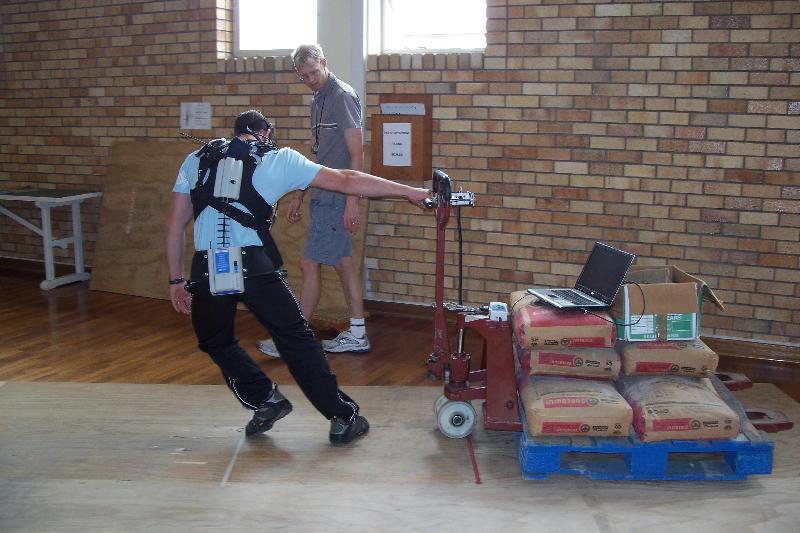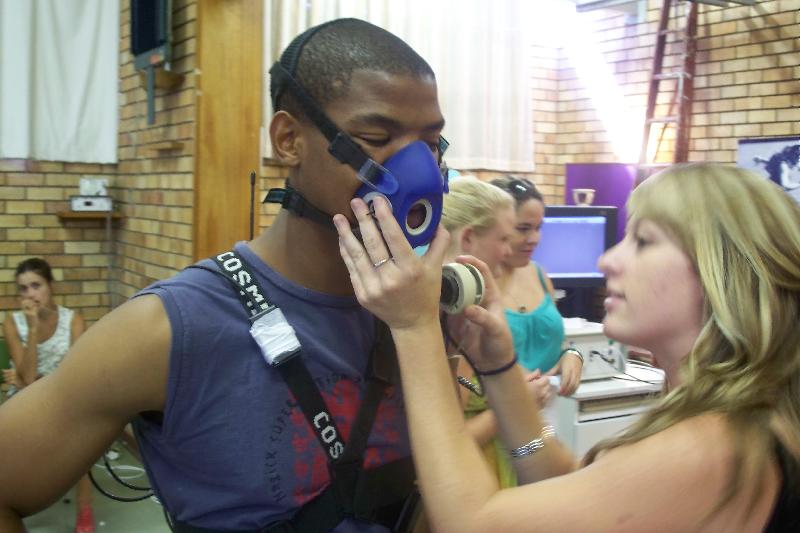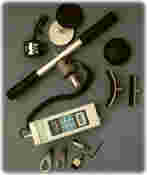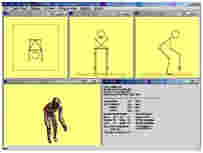Rhodes University Human Kinetics and Ergonomics Department Resources
Departmental Resources
Facilities
The HKE department has excellent facilities, both in terms of teaching and research facilities. There is a 100 seat lecture theatre that is used both by the department and the university at large to facilitate lectures at an undergraduate level.
The department is also fortunate to have four laboratories, which are used extensively for teaching, laboratories and research. A brief outline of each of the laboratories is provided below:
The Physiology Laboratory:
This lab is used lectures, laboratories and research. It houses most of the physiological equipment, allowing us to do in depth investigations into the cardiovascular, respiratory and muscular systems of the human body. Equipment such as the Metalyzer by Cortex, a breath by breath metabolic system is used to teach undergraduate students the basics of physiology, while it is also used to do in depth research at the postgraduate level.
A student being fitted with the breath by breath metabolic system used to investigate the physiological responses to physical activity
The Biomechanics and Clinic Laboratory:
This laboratory is used extensively for both laboratories and research purposes. It houses numerous biomechanics orientated pieces of equipment. These include the industrial Lumbar Motion Monitor (pictured below) which is used extensively to demonstrate the movement of the spine in three dimensions.
The Laboratory has a walkway constructed in it, in order to facilitate pushing and pulling research. In particular this research has focussed on an assessment of the biomechanical demands placed on the human operator during the manipulation of manual handling devices such as trolleys and pallet jacks.

Research being conducted on the walkway using the Lumbar Motion Monitor to assess the risk of injury to the lower back.
Equipment
The Department of Human Kinetics and Ergonomics utilises a wide range of equipment. In maintaining the holistic nature of research into human responses and potential within the Department, biomechanical, physiological and psycho-physiological equipment is used.
Equipment includes:
- Cortex Metalyzer
- Cortex MetaMax – portable ergospirometry system
- Polar heart rate watches and belts
- Gait Analysis Walkway
- DartFish – Motion Analysis Software
- 3DSSPP Software
- Dikablis Eye Tracker
- Audiometer and luminance meter
- Force Platform
- Neurocon Balance Master – specialized rehab force platform
- Biodex – isokinetic dynamometer
- Lumbar Motion Monitor
- Zebris Motion Analysis system – allows 3D motion analysis
- Chatillon Dynamometers
- Biometrix Data Logger
- Thermographic camera (FLIR)
Some of the equipment used is described in more detail below:
ENRAF-NONIUS ENTREE
EntreeM
WHAT DOES IT DO?
The Entree system is a Windows-linked stack-weight isoinertial machine which can be used to assess the efficiency of movement and strength in both testing and rehabilitation settings.
Assessment of: Power, velocity, force and work
HOW DOES IT WORK?
The system works on a single or double wire pulley which is connected to a weights stack system section. Various movement patterns are executed by upper- and lower limbs when testing clients. The computer allows for graphical comparisons of different sides of the body and also for test/re-test protocols.
WHAT ARE THE USES OF THE DATA?
Data are particularly useful in a rehabilitation setting, as the graphs of early testing of strength and range of motion can be compared to repetitions completed at a later stage. The data may also be useful in disability assessment where imbalances in muscle strength on the left and right side can be identified and targeted.
CHATILLON DYNAMOMETERS CSD 400 and 500 MODELS
Chatillon
WHAT DOES IT DO?
The hand-held apparatus allows for basic assessment of isometric force (in kg.f) produced in a clinical or ergonomics situation. Basic movements can be performed to measure, for example, neck and arm strength.
Assessment of: Force
HOW DOES IT WORK?
Readings are calculated from a push or pull force exerted by the subject. Measurements are taken by securing the dynamometer on a wall or in the hand, with the subject then exerting a force. As it is often difficult to measure accurately on the first trial, a number of trials (maximum of 5 trials) should be carried out.
WHAT ARE THE USES OF THE DATA?
A base of comparison can be established between isokinetic dynamometry data and in-situ isometric data. The equipment can be used on a more regular basis than the Cybex due to its ease of use and portable nature.
BIODEX ISOKINETIC DYNAMOMETER


Biodex – Honours Practical
WHAT DOES IT DO?
The Biodex system provides a test of isokinetic muscle strength. The speed of the machine stays constant throughout the range of motion, for example, 60.s-1. It is up to the subject to “catch” the machine and express maximal force through the full range of motion.
Assessment of: Torque, work and power outputs
HOW DOES IT WORK?
Isokinetic devices permit individuals to exert as much force and angular movement as they can generate – whether they are a frail rehabilitation client or a robust athlete – at a predetermined velocity. The subject must therefore aim to go as fast and as hard as possible against the machine which in turn will offer an accommodating resistance.
WHAT ARE THE USES OF THE DATA?
Data collected can be compared to normative values and test/re-test values can be obtained. Improvements in torque, work and power outputs can be plotted on graphs and used as a form of motivation for the subject.
LUMBAR MOTION MONITOR

lumbar
WHAT DOES IT DO?
The Lumbar Motion Monitor (LMM) assesses the dynamic component of lifting tasks in industrial or laboratory settings.
Assessment of: Lumbar displacement, velocity and acceleration
HOW DOES IT WORK?
The LMM consists of a tri-axial electrogoniometer that acts as a lightweight exoskeleton of the lumbar spine. It is positioned on the back of the subject directly in line with the spine and attached by a harness at the pelvis and thorax. Four potentiometers at the base of the LMM measure instantaneous position of the spine in 3D space relative to the pelvis.
WHAT ARE THE USES OF THE DATA?
The LMM can be used in-situ to assess the forces placed on the spine while executing a manual task. That task can be compared to a large database of jobs from different sectors of industry/manufacturing to review risk level. The LMM can also assist in determining whether or not ergonomics intervention is required at a specific work station.
3DSSPP
3dssp
WHAT DOES IT DO?
This is a three dimensional software package that can be used to translate two dimensional photographs into three dimensional human mannequins. The software calculates the predicted musculoskeletal forces in the various joints of the body as well as giving an indication of whether or not they are within acceptable limits.
Assessment of: Musculoskeletal forces and torques
HOW DOES IT WORK?
The ErgoImager software package allows you to accurately translate a two dimensional photograph into a three dimensional mannequin in the appropriate working posture. The 3DSSPP software then calculates the forces involved by taking the load being moved into account as well as the direction the load is being moved in.
Metalyzer and MetaMax Systems
WHAT DOES IT DO?
The MetaMax is a portable ergospirometry system whose mobility, low weight, stable sensors, easy operation and integrated telemetry system show its advantages over other conventional stationary methods. The system provides all data needed for a complete function analysis of the lungs, heart, circulation and metabolism under varying conditions. The Metalyzer is the stationary equovalent of the MetaMax system.
Assessment of: Energy expenditure
HOW DOES IT WORK?
The Metalyzer and MetaMax base units contain the complete electronics for measuring and processing of physiological responses during a given period. The main parts of the processing unit consist of several microprocessors; in addition several sensors and mechanical components are controlled by these microprocessors.
WHAT ARE THE USES OF THE DATA?
The Metalyzer and MetaMax provide test results measured under real conditions and avoids the need for expensive simulation setup. It is important to those involved in sports science, ergonomics and occupational health. Data can be used to optimize training programmes or working conditions.
Journal subscriptions
The Rhodes University library hold an encylopaedic collection of historical and contemporary journals in the fields of sports science, ergonomics and health & wellness.
The Main library has numerous books associated with HKE, for a full list please see the file attached:
HKE library books



